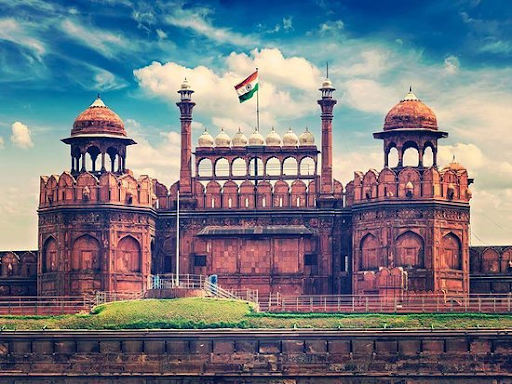Red Fort
Why in News:
- The Delhi High Court dismissed a petition by the wife of the late Mirza Mohammed Bedar Bakht, great-grandson of last Mughal emperor Bahadur Shah Zafar to hand over to her the possession of the Red Fort.
About

- The Red Fort Complex was built as the palace fort of Shahjahanabad – the new capital of the fifth Mughal Emperor of India, Shah Jahan. Shah Jahan, after ruling from Agra for eleven years, decided to shift to Delhi and laid the foundation stone of the Red Fort in 1618.
- Named for its massive enclosing walls of red sandstone, it is adjacent to an older fort, the Salimgarh, built by Islam Shah Suri in 1546, with which it forms the Red Fort Complex.
- For its inauguration in 1647, the main halls of the palace were draped in rich tapestry and covered with silk from China and velvet from Turkey.
- With a circumference of almost one and a half miles, the fort is an irregular octagon and has two entrances, the Lahore and Delhi Gates
- The private apartments consist of a row of pavilions connected by a continuous water channel, known as the Nahr-i-Behisht (Stream of Paradise).
- The Red Fort is considered to represent the zenith of Mughal creativity which, under the Shah Jahan, was brought to a new level of refinement.
- The planning of the palace is based on Islamic prototypes, but each pavilion reveals architectural elements typical of Mughal building, reflecting a fusion of Persian, Timurid and Hindu traditions. The Red Fort’s innovative planning and architectural style, including the garden design, strongly influenced later buildings and gardens in Rajasthan, Delhi, Agra and further afield
Elements of the Red Fort
- The Diwan-e-Aam is the Red Fort’s hall of public audience. The Mughal emperors would hold court here and meet dignitaries and foreign emissaries. In the recess behind the platform are fine examples of Italian Pietra-Dura work.
- Pietra-Dura is a term for the inlay technique of using cut and fitted, highly polished colored stones to create images. It is considered a decorative art.
- The piece de resistance of the fort, the Diwan-e-Khas was the hall of private audience. The most highly ornamented of all Shah Jahan’s buildings, Diwan-e-Khas is a pavilion of white marble supported by intricately carved pillars. So enamoured was the emperor by the beauty of this pavilion that he engraved on it the following words: “If there is paradise on the face of this earth, it is this, it is this.”
- Richly decorated with flowers of inlaid mosaic work of cornelian and other stones, the Diwan-e-Khas once housed the famous Peacock Throne, which when it was plundered by Nadir Shah in 1739
Significance of Red Fort
- The Mughal emperor was so closely identified with legitimate government in the public mind that when the country revolted in 1857, the mutinous soldiers made their way to Delhi, seeking his command. When the insurrection in Delhi was subdued, the British forces took over the Red Fort, and officers drank to their Queen’s health in the Diwan-e-Khas, where Mughal kings had held court.
- It was in this hall that Bahadur Shah was tried, condemned, and deported.
- In 1945-46, personnel from the Indian National Army were tried there, sparking a massive wave of nationalist fervour in the run-up to independence..
- It was also from its ramparts that the first Prime Minister of India, Pandit Jawharlal Nehru, announced to the nation that India was free from colonial rule.
- Every year on India’s Independence Day (15 August), the Prime Minister hoists the Indian tricolour flag at the fort’s main gate and delivers a nationally broadcast speech from its ramparts.
- The Red Fort Complex is managed directly by the Archaeological Survey of India, which is also responsible for the protection of all national level heritage sites in India and Indian cultural properties included in the World Heritage List.
References:
- https://www.indiaculture.nic.in/red-fort-complex
- https://indianexpress.com/article/explained/red-fort-and-delhi-symbols-and-narratives-of-power-down-the-ages-7167129/
- https://www.thehindu.com/news/national/hc-rejects-plea-for-red-fort-possession-by-bahadur-shah-zafars-great-grandsons-wife/article37999323.ece
Subscribe
Login
0 Comments
